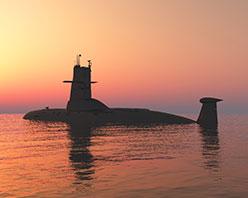ONE OF THE BIGGEST CHALLENGES SUBMARINERS FACE WHILE ON DUTY IS HOW TO CREATE BREATHABLE AIR ONBOARD A SUBMARINE.
There are two main factors to consider here, the first is to make oxygen and the second is to remove the CO2 in the atmosphere, all while trying to navigate the depths of our oceans.
There are two safe ways of creating breathable oxygen onboard a submarine:
1. ELECTROLYSIS
Submarines produce the majority of the oxygen they need by liberating it from the surrounding water. A water molecule consists of two hydrogen atoms and one oxygen atom: H2O. Most of the world’s water is found in the oceans – the natural roaming grounds of submarines, making it extremely convenient to use the seawater as an oxygen source.
The water must first be distilled in-order to remove impurities such as salts. This is achieved by heating the seawater to create water vapor. This process leaves the salts behind to then be cooled and collected in a collection tank.
An electrical current is then passed through the purified water (electrolysis) which separates the water molecule into its constituent parts: hydrogen and oxygen. By passing an electrical current through the water, the molecules separate and recombine to form oxygen.
2. OXYGEN CANDLES
A chlorate candle, or an oxygen candle, is a cylindrical chemical oxygen generator that contains a mix of sodium chlorate and iron powder. Once ignited, it smolders at about 600 °C (1,112 °F), producing sodium chloride, iron oxide, and at a fixed rate of about 6.5 man-hours of oxygen per kilogram of the mixture. The mixture has an indefinite shelf life if stored properly: candles have been stored for 20 years without decreased oxygen output.
CO2 SCRUBBING
In-order to remove CO2 from the atmosphere, the submariners use a process called ‘CO2 Scrubbing’. This is done chemically using soda lime (sodium hydroxide and calcium hydroxide) in devices called ‘scrubbers’. The CO2 is trapped in the soda lime by a chemical reaction and removed from the air, ensuring a safe breathing atmosphere is maintained.
Another way is by using lithium hydroxide canisters, that once exposed to the atmosphere, it will take CO2 out of the air. An advantage of using the lithium hydroxide method is that it will still work in the event of a power outage onboard, so is a very effective, passive way of removing CO2 out of the atmosphere.
Removing CO2 from the atmosphere onboard a submarine is essential inorder to keep the personnel alive. The most effective first stage is being able to monitor the atmosphere in any given area of the sub and to identify any gas leaks or build up of unwanted gases on board.
Analox has over 20 years experience in dealing with the submarine industry and have created many tried and tested gas monitors to suit all applications onboard a submarine.
A CAMS (Central Atmospheric Monitoring System) unit monitors the amount of gases in the submarine atmosphere, and is considered mission-essential equipment and vital to the deployment of submarines. This centrally located unit displays the various gas readings throughout the submarine, in one convenient location, allowing for difficult decision making to be a thing of the past.
Analox understands the critical importance of ensuring personnel are protected by appropriate and effective gas monitoring – especially in the submarine arena. We are dedicated in offering you a personalized service ensuring cradle to grave product lifecycle is tailored to suit your specific requirements.
The Analox Design and Engineering teams’ hard work ensures we are able to offer innovative equipment which is optimised to suit the environment and designed to be supported effectively throughout the platform’s life.
The Analox technical support team offers bespoke training depending upon your requirements, whether that is face to face or a computer simulated package.
To understand how Analox can work with you at sea, head over to our Submarines page to view the full range.
